#business-transportation-london
Explore tagged Tumblr posts
Text
Premium Corporate Chauffeur Services and London Private Hire by WeUniversal
Elevate your travel experience with WeUniversal, offering top-notch Corporate Chauffeur Services and London Private Hire. Whether for executive meetings, corporate events, or private journeys, our professional chauffeurs and luxury vehicles ensure a seamless, stylish, and comfortable ride. Book now and enjoy unmatched reliability, elegance, and professionalism.

#corporate-chauffeur-services#london-private-hire#business-transportation-london#luxury-corporate-travel#weuniversal-chauffeurs#executive-chauffeur-london#private-hire-london
0 notes
Text
Metalman Auto files draft papers with SEBI to raise funds via IPO
The IPO consists of a fresh issue of Rs 350 crore and an offer for sale of upto 12.64 million shares by its existing shareholders and promoters.
Metalman Auto Ltd has submitted a Draft Red Herring Prospectus (DRHP) to the Securities and Exchange Board of India (SEBI) to raise capital through an Initial Public Offering (IPO). The IPO includes a fresh issuance of shares worth Rs 350 crore and an offer for sale of up to 12.64 million shares by the company’s current shareholders and promoters.
The proceeds from the fresh issue will be allocated as follows: Rs 25 crore will be used to partially finance the capital expenditure for the procurement of plant and machinery at the Pithampur manufacturing unit 2. The company also plans to utilize Rs 240 crore to repay a portion of its existing debt. As of June 2024, Metalman Auto Ltd has a total debt of Rs 314.43 crore.
The firm operates nine manufacturing units across five states in India, strategically located near OEM customers to ensure efficient production and supply. Axis Capital, ICICI Securities, and Motilal Oswal Investment Advisors are the lead managers for this issue.
Metalman Auto Ltd is a leader in the metal fabrication, finishing, and assembly sector in India, specializing in the production of metal components for two-wheelers (including both electric and internal combustion engines), three-wheelers, passenger vehicles, commercial vehicles, agri-vehicles, and off-highway vehicles. Additionally, the company manufactures aesthetic components for white goods, such as panels for washing machines, and offers contract manufacturing services for two-wheeler electric vehicle (2W EV) OEMs.
#metalman auto#oem manufacturing#oemparts#electric vehicles#metal fabrication#fabricationservices#steel fabrication#supplier#manufacturer#stainless steel#transport technology#transport service#transport for london#vehicle transport#transportation#ipo news#ipo alert#markets#stocks#business standard#business magazines#High-Volume Automotive Parts Manufacturing#manufacturing#automotive parts#parts Manufacturin#automotive industry#automotive#car accessories
2 notes
·
View notes
Text
Green Chauffeurs London – Experience Luxury with Tesla Chauffeur Services
Luxury Meets Sustainability: Tesla Chauffeur Service in London
As the world moves toward greener and more sustainable transport solutions, the demand for Green Chauffeurs in London is growing rapidly. Luxury travel is no longer just about comfort and style—it’s also about making eco-conscious choices. If you’re looking for an exceptional, zero-emission travel experience, a Tesla chauffeur service in London is the perfect choice.
Why Choose a Tesla Chauffeur in London?
A Tesla chauffeur service offers the best of both worlds—sophisticated, high-end transportation with an environmentally friendly approach. Unlike traditional vehicles, Tesla taxis in London produce zero emissions, helping reduce air pollution while offering a seamless, quiet, and comfortable ride.
Whether you're traveling for business or leisure, a chauffeur-driven Tesla ensures an elegant journey with state-of-the-art features such as autopilot assistance, premium interiors, and advanced safety technology.
The Benefits of Eco-Friendly Taxis in London
Opting for an eco-friendly taxi in London means you are contributing to a more sustainable city while enjoying luxury transportation. Some key advantages include:
Zero-Emission Travel: Reduce your carbon footprint with an all-electric Tesla.
Premium Comfort: Enjoy a smooth, noise-free ride with spacious interiors.
Advanced Technology: Tesla’s innovative features make every journey efficient and enjoyable.
Reliable and Professional Service: Expert chauffeurs ensure punctual and discreet transport.
Green Chauffeurs London – The Future of Sustainable Travel
By choosing a green chauffeur company, you’re not only investing in a premium travel experience but also supporting environmentally responsible transport. Whether for corporate clients, airport transfers, or special events, a Tesla chauffeur in London provides first-class service with sustainability at its core.
For those who want a stylish and eco-conscious way to navigate the city, Tesla taxis in London are the ultimate solution. Whether you need a short city trip or a long-distance journey, an electric chauffeur service ensures a smooth and responsible travel experience.
Book Your Tesla Chauffeur Service Today
Luxury and sustainability go hand in hand with Green Chauffeurs in London. Choose a Tesla chauffeur service in London for a guilt-free, high-end travel experience that prioritizes comfort, efficiency, and environmental responsibility.
Travel smarter, travel greener—choose a chauffeur-driven Tesla for your next journey!
#Green Chauffeurs London#Tesla Chauffeur Service London#Tesla Chauffeur London#Tesla Taxis London#Chauffeur Driven Tesla#Eco-Friendly Taxis London#Green Chauffeur Company#Luxury Electric Chauffeur London#Sustainable Chauffeur Service#Zero Emission Chauffeur London#Executive Tesla Chauffeur London#Premium Green Transport London#Tesla Airport Transfers London#Business Travel Tesla Chauffeur#Eco Luxury Travel London
0 notes
Text
Heathrow Airport Chauffeur Service - Private Hire Car and Driver
Heathrow Airport Chauffeur Service The Ultimate in Luxury Travel Crony Chauffeur Services offers a premium Heathrow Airport Chauffeur Service designed to deliver luxury, comfort, and convenience. Whether you’re arriving at or departing from Heathrow Airport (Terminals 2, 3, 4, or 5), Crony Chauffeur Services ensures a seamless and stress-free travel experience. With a fleet of world-class…

View On WordPress
#airport cab booking#airport cab service#airport cabs#airport cabs london#airport cars#airport london transfer#airport shuttle#airport taxi#airport taxi booking#airport taxi cab services#airport taxi london#airport taxi service#airport taxi transfers#airport transfers#airport transfers london uk#airporttaxis uk#booking airport transfers#bristol taxi airport#business chauffeur hire#cab to airport#call taxi cab#car hire with driver#car transport#car with driver on rent#chauffeur driven#chauffeur driver#chauffeur hire#chauffeur hire london#chauffeur service#chauffeur service cost
0 notes
Text
INSANE talent at triangulating where people are located via grindr & scruff
#stream#just insane behaviour IN GENERAL ALSKALSKALSKALSLALSLAL#IM SOOOOOOOO UNHINGED#i’m like ‘hmm where is he … well it’s 4800 miles away …’ ok so he’s in london ‘what part of london …’#took me like 10 minutes he’s near trafalgar#ALSKALSKALSLAKSLAKSLLALSLA#NOT EVEN 10#like ‘good for him ! right in the heart of american tourist spots … near good transport … ‘high class’ location w the amenities … this is#unsurprising’ ALSKALSKALSKALSKALKSALS LIKE GIRL CAN U JUST MIND UR OWN BUSINESS FOR ONCE#i remember getting soooo fucking high there then getting lost trying to leave like girl … ITS A FUCKING CIRCLE#& i went on a ghost tour or some shit on a ghost bus near there it was so fucking funny big recommend i love london i can’t wait to go back
0 notes
Note
Hey bestie whats a narrow boat? I saw you tag that on something you reblogged and I'm pretty curious now!
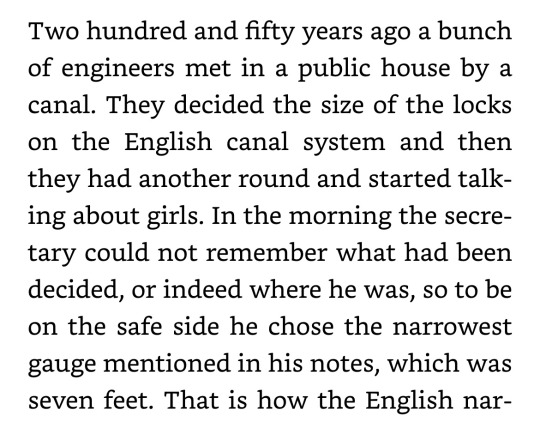

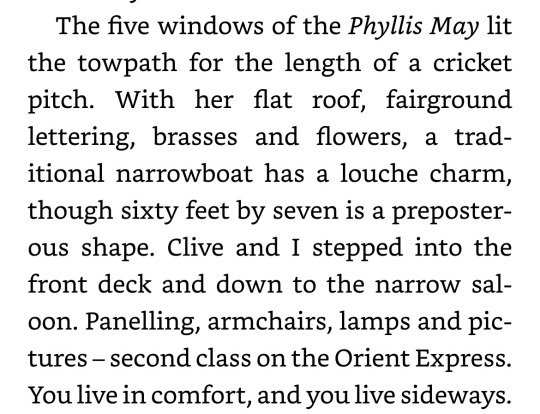
- Terry Darlington, Narrow Dog to Carcassone
A narrowboat (all one word) is a craft restricted to the British Isles, which are connected all over by a nerve-map of human-made canals. To go up and down hills, the canals are spangled with locks (chambers in which boats can be raised or lowered by filling or emptying them with water.) As Terry says above, the width of the locks was somewhat randomly determined, and as a result, the British Isles have a narrow design of lock - and a narrowboat to fit through them. A classic design was seventy feet long and six feet wide. Starting in the 18th century, and competing directly with trains, canal “barges” were an active means of transport and shipping. They were initially pulled along the towpaths by horses, and you can still see some today!
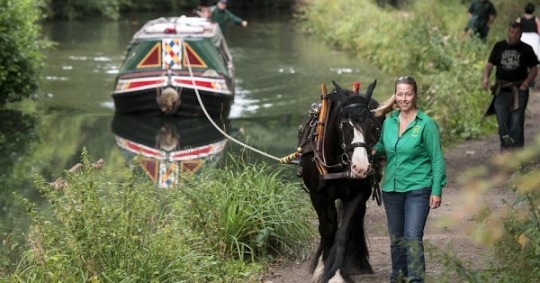
Later, engines were developed.
Even after the trains won the arms race, it was a fairly viable freight service right up until WW2. It’s slow travel, but uses few resources and requires little human power, with a fairly small crew (of women, in WW2) being capable of shifting two fully laden boats without consuming much fossil fuel.
In those times the barges were designed with small, cramped cabins in which the boaters and their families could live.
During its heyday the narrowboat community developed a style of folk art called “roses and castles” with clear links to fairground art as well as Romani caravan decor. They are historically decorated with different kinds of brass ornaments, and inside the cabins could also be distinctively painted and decorated.
Today, many narrowboats are distinctively decorated and colorful - even if not directly traditional with “roses and castles” they’ll still be bright and offbeat. A quirky name is necessary. All narrowboats, being boats, are female.
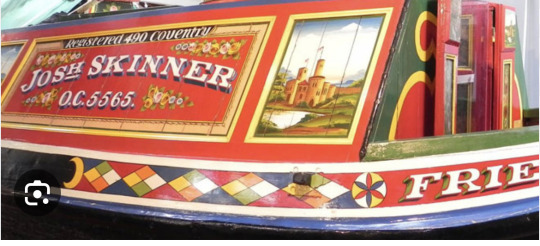
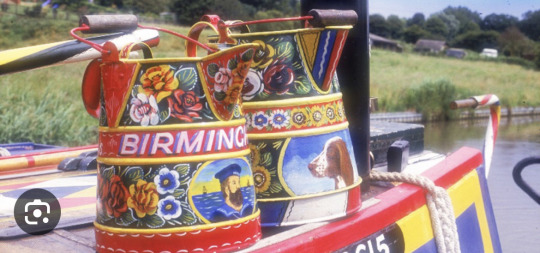
After a postwar decline, interest in the waterways was sparked by a leisure movement and collapsing canals were repaired. Today, the towpaths are a convenient walking/biking trail for people, as they connect up a lot of the mainland of the UK, hitting towns and cities. Although the restored canals are concrete-bottomed, they’re attractive to wildlife. Narrowboats from the 1970s onward started being designed for pleasure and long-term living. People enjoy vacationing by hiring a boat and visiting towns for a cuter, comfier, slower version of a campervan life. And a liveaboard community sprang up - people who live full-time on boats. Up until the very restrictive and nasty laws recently passed in the UK to make it harder for travelling peoples (these were aimed nastily at vanlivers and the Romani, and successfully hit everyone) this was one of the few legal ways remaining to be a total nomad in the UK.
Liveaboards can moor up anywhere along the canal for 28 days, but have to keep moving every 28 days. (Although sorting out the toilet and loading up with fresh water means that a lot of people move more frequently than that.) you can also live full-time in a marina if they allow it, or purchase your own mooring. In London, where canal boats are one of the few remaining cheapish ways to live, boats with moorings fetch the same prices as houses. It can be very very hard for families to balance school, parking, work, and all the difficulties of living off-grid- but many make it work. It remains a diverse community and is even growing, due to housing pressures in the UK. Boats can be very comfortable, even when only six feet wide. When faced with spending thousands of pounds on rent OR mooring up on a nice canal, you can see why it seems a romantic proposition for young people, and UK television channels always have slice-of-life documentaries about young folks fixing up their very own quirky solar-powered narrowboat. I don’t hate; I did it myself.
If you’re lucky, you might even meet some of the cool folks who run businesses from their narrowboats: canal-side walkers enjoy bookshops, vegan bakeries, ice-cream boats, restaurants, artists and crafters. There are Floating Markets and narrowboat festivals. It’s generally recognised that boaters contribute quite a lot to the canal - yet there are many tensions between different kinds of boaters (liveaboards vs leisure boaters vs tourists) as well as tensions with local settled people, towpath users like cyclists, and fishermen. I could go on and on explaining this rich culture and dramas, but I won’t.
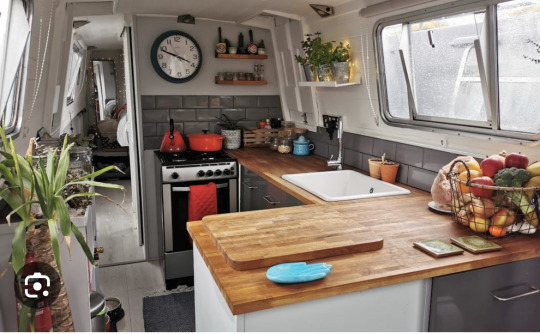
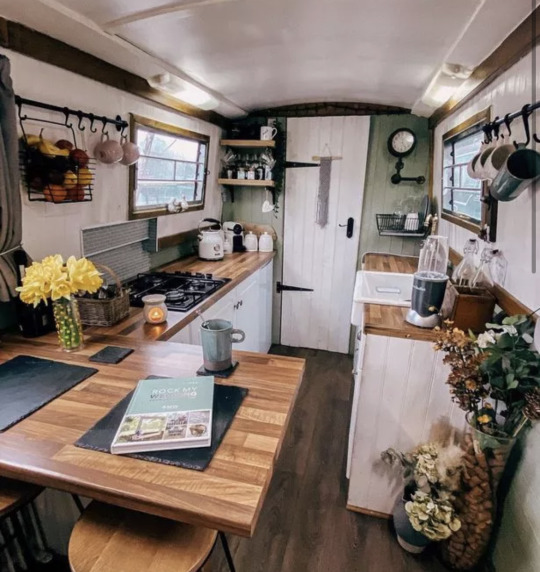
Phillip Pullman’s Gyptians are a commonly cited example of liveaboards - although they were based on the narrowboat liveaboards that Pullman knew in Oxford, their boats are actually Dutch barges. Dutch barges make good homes but are too wide to access most of the midlands and northern canals, and are usually restricted to the south of the UK. So they’re accurate for Bristol/London/Oxford, and barges are definitely comfier to film on. (Being six feet wide is definitely super awkward for a boat.) but in general Dutch barges are less common, more expensive and can’t navigate the whole system.
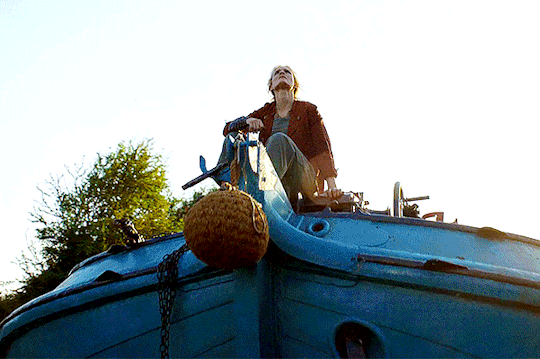
However, apart from them, there are few examples of narrowboat depictions that escaped containment. So it’s quite interesting that there is an entire indigenous special class of boat, distinctive and highly specialised and very cute, with an associated culture and heritage and folk art type, known to all and widely celebrated, and ABSOLUTELY UNKNOWN outside of the UK - a nation largely known around the world for inflicting its culture on others. They’re a strange, sweet little secret - and nobody who has ever loved one can resist pointing them out for the rest of their lives, or talking about them when asked to. Thank you for asking me to.
6K notes
·
View notes
Note
Have you heard about the global day of action on March 2?
Yes! I have! Here's more info about it (click). Here, from the "About" section:
There is a growing global movement for a Free Palestine. Across the world, millions of people are engaging in demonstrations and organizing major marches in solidarity with Palestine. Our demands for an immediate ceasefire, cutting all aid to Israel, and lifting the siege on Gaza have broader support than ever. On November 4th, over 500,000 gathered in Washington DC for the largest march in recent times to stand in solidarity with Palestine. Protests with half a million people erupted on the streets of London, constituents across Canada occupied over 17 MP offices from coast to coast, and Belgian dock workers' unions have refused to transport weapons by plane or sea that are destined for Israel. We must keep building momentum and increase the pressure with more marches, walk-outs, sit-ins, and other forms of direct action directed at the political offices, businesses, and workplaces that fund, invest, and collaborate with Israeli genocide and occupation. NOW is the time for our mobilizations to grow in size, frequency, and focus; building a political climate that makes Israel’s business of genocide unsustainable.
Already protesters have shut down highways, train stations, and bridges in the United States; activists have targeted Israeli weapons manufacturers; Belgian dockworkers’ unions have refused to handle weapons transports to Israel; Bolivia has cut diplomatic ties with Israel while Jordan, Chile, and Colombia have recalled their Israeli ambassadors. Be part of the change, take action, and make your voice heard as the global struggle for Palestine enters a new phase.
Join the Shutdown for Palestine on Friday, December 8, 2023. We call on movements, organized labor, youth, students, media and healthcare workers, and all members of society to join us in demanding an immediate ceasefire, cutting all aid to Israel, and lifting the siege on Gaza. This call to action started on November 9, but we will continue to build up the momentum with ongoing days of action. No business as usual until Palestine is Free!
Walk out from work and/or school
Picket Israeli embassies and consulates
Picket against companies that profit from Israel’s occupation of Palestine (Lockheed Martin, Boeing, Raytheon, Northrop Grumman, General Dynamics, Elbit Systems)
Host speak outs
Wear kuffiyehs
Wear black armbands
859 notes
·
View notes
Text
Tips for writing London as a setting if you've never been there
London's a popular place to set a story! It's often imagined as sexy, cool, and suave. Whilst this is sometimes true, the thing that it predominantly is, is absolutely and entirely chaotic! So here are some aspects that you may not know about:
-Public transport is absolutely crucial to the infrastructure! Few people drive in London because of how well connected it is, and bus stops and train stations are often used as meeting points or details in directions.
-There's a LOT of crime, like, a lot. All cities have it, but London has a lot of variety. Stabbings are incredibly common (to the extent where it becomes a bit of a joke), almost everyone has a story where they've found or seen a dead body, and there are many money laundering/drug den fronts under the guise of highstreet shops (they're not well hidden).
-Despite it's chaos there's a strong code of etiquette most people hold themselves too. Some are actual rules (stand on the right side of escalators, don't queue jump) but some are simply social expectations (don't stop in the middle of the pavement, keep your bags close to your body, don't take up multiple seats.)
-A lot of tourists to the city are COMPLETELY FERAL and widely hated. They'll stand in the middle of the road, block up bridges, swing around cameras and selfie sticks in busy places, and completely ignore the social standards of polite society. People Do Not Like This. (also American tourists have a tendancy to just randomly start conversation with people? It's a bit weird and generally not done but it's not strictly a bad thing.)
-Rush hour is INSANE. We're talking almost static traffic, trains so packed that you're pressed into people on every side, buses that are so full they can't stop to let more people on. Some days it's better some days it's worse, but if you can avoid travelling at those times YOU DO.
-There are a lot of scam artists on the streets. Most major cities have these, they suck, they're aggressive, and they'll take your money! Some give you flowers and then force you to pay, some take photos of you and boost up the price to get them, there's always new ones, they're relentless, and you've gotta tell them to fuck off.
-Black cabs are not at all popular for normal people! They cater to tourists, rich people, and old people. They're great, the cab drivers are hard working and very knowledgeable, but they're also very expensive. Awful as it is, uber's cheaper if you're desperate, but buses go everywhere so it's just not really worth it.
#I wrote this ages ago but I just went on a trip to America and realised actually this might help people#London is truly an ecosystem of it's own that you get so used to it kinda feels weird to be anywhere else?#But it's a very walkable city and I like it so I'm okay with that 😌#Tma#The magnus archives#Tma fanfic#Fanfic#London#Writing#Writing tips#fanfiction#I don't know what else to tag this so let's just hope it ends up with the right people somehow 😌
229 notes
·
View notes
Text
Why Aziraphale's White Satin Pumps Are Ridiculous (And I love them)
So this is a continuation of the lengthy rant I posted here about Aziraphale's outfit in the Bastille scene of GO and all the ways it would have pissed people in Revolutionary Paris off. I got to the shoes and realized they needed their own post.
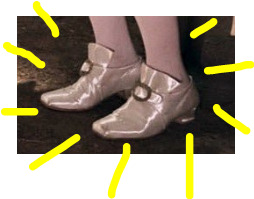
Aziraphale's Blessed Little White Satin Pumps
To recap: in 1793, Paris is in control of The People, who are making up for decades of oppression and poverty by beheading the fuck out of everyone remotely nobility-adjacent. And into this mess strolls one Angel in white satin heels.
Some facts about this style of shoe:
The buckle means they're specifically court shoes as opposed to streetwear. Buckles were out of fashion unless you were hanging out with royalty and needed to look fancy. Everyday shoes had laces by this point.
This heel style for men is specifically called Louis Heels because they were popularized by Louis XVI. Y'know... the king Paris just beheaded in 1793. Here's a pair in a similar style from the late 18th century:
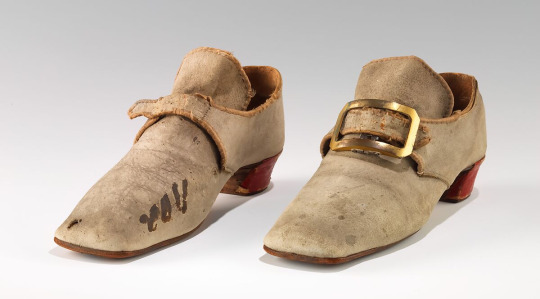
One big difference you may notice in Aziraphale's shoes and the ones above is that the ones above are normal, practical leather whereas Aziraphale is wearing white satin shoes. This is because Aziraphale is ridiculous.
The Allure of White Satin Shoes
In this modern world of laundry machines and affordable shoes I feel that people do not fully understand how absolutely over-the-top ridiculous a pair of white satin shoes would be to people in 1793.
First off lets address the fact that they're white:
If you have ever known anyone who was super into sneakers, you know that keeping white shoes white is a full-time job. It was even more so in the 18th century. The fact that Aziraphale is wearing perfectly clean white shoes says one thing: "I am rich enough to be able to pay someone to clean these, and to replace them when they invariably get stained."
And they would get stained. Oh would they get stained.
Because he is not wearing them for their intended function - lazing around indoors. No, he is wearing them on the streets of 18th Century Paris. And 18th Century Paris was fucking disgusting.
Kind of like how London had its famed London Smog, Paris had its own brand of filth. A unique Parisian muck made up of mixtures of mud, offal from the slaughterhouses, animal waste, human waste, household garbage, and rotting dead animals, all mashed down into what a British visitor called, "A thick, black, unctuous oil, that where it sticks no art can wash it off."

Voltaire said: "We blush with shame to see the public markets, set up in narrow streets, displaying their filth, spreading infection, and causing continual disorders…" and called Paris a city, "Partly of gold and partly of muck."
This is a city with over a million people, with no central plumbing, and no public sanitation laws. Households threw their waste in the streets. Businesses like tanneries and slaughterhouses threw their waste right out into the streets. Horses were the main mode of transportation and nobody was cleaning up after them. It was apparently a thriving hustle that Parisian beggars would hang out in the worst areas with big pieces of wood, and charge wealthy people money to walk on the board over the worst puddles of filth.

That's where Aziraphale is wearing his pristine little white satin shoes. In a city so gross it has its own world-renowned stinking black mud.
And on the subject of those shoes, lets look at the satin part... By the 18th Century, France was no longer dependent on Asia for its silk and satin. There was domestic production, but it was still expensive. A book about the cost of living published in London in 1770 lists the price for a single yard of satin at just over 18 shillings. For comparison, here are some other things you could get for 18 shillings in London at the time:
two box seats at Covent Garden
six barrels of oysters
a really nice wig
a week's wages for a skilled tradesman
15 steak dinners
3 secondhand coats So the outer fabric alone on Aziraphale's shoes cost what it would take a skilled worker about a week to make. Again, that's just for the fabric. Since the shoes themselves were high quality, would be handmade, and required skilled labor, the shoes themselves would be expensive even without the satin. In 1788 a pair of leather gentleman's court shoes cost about 6 livres in France. By comparison, a pound of bread, which was considered a day's food for a peasant, cost roughly 10 sous. So we'll roughly estimate that Aziraphale's shoes without the satin cost the equivalent of 12 days worth of food for an average person.
And, I cannot stress this enough, he is wearing these white shoes, which could easily feed an entire family for weeks, in a city that is abso-fucking-lutely filthy with stinking, staining, sticky mud.
Aziraphale's shoes, probably:

I mean - imagine you're a normal everyday French peasant during the Revolution. You spend decades struggling to feed your family, and some dingbat walks up to you in white court shoes styled after the king you just executed. Shoes that cost more than you make in a month, which he is wearing around your notoriously filthy city with apparently 0 fucks given for the fact that they will be absolutely ruined and will have to be thrown away. (Obviously Aziraphale could just miracle them clean but you're a revolutionary peasant, you don't know that.)
And then this walking audacity asks you for cake.
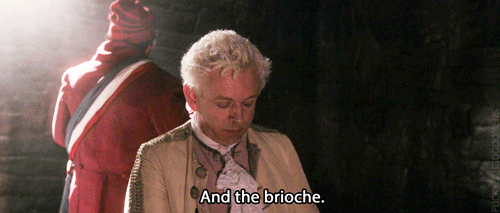
Aziraphale, hon, you are so lucky they decided to try to execute you and not just like. jump your dumb ass in an alley and steal your pretty little white satin shoes.
#good omens#ineffable husbands#good omens meta#good omens costumes#aziraphale#aziraphale's white satin pumps
351 notes
·
View notes
Text

Olaudah Equiano (c. 1745–1797) was a prominent African writer, abolitionist, and former enslaved person whose autobiography played a key role in the abolition of the transatlantic slave trade. Born in what is now southeastern Nigeria, Equiano was captured as a child and sold into slavery. He was transported across the Atlantic to the Americas, where he endured the brutal conditions of slavery in the West Indies, the American colonies, and later in the British Navy.
Equiano’s story is remarkable not only because of his survival and eventual freedom, but also because of the way he used his life experiences to advocate for the end of slavery. After gaining his freedom in 1766, Equiano moved to London, where he became active in the abolitionist movement. His autobiography, The Interesting Narrative of the Life of Olaudah Equiano (1789), was one of the first major works to be written by an African author about the horrors of slavery. The book became widely read and influential, helping to bring attention to the inhumanity of the slave trade and contributing to the growing movement to abolish it in Britain.
Equiano described his early life in Africa, his abduction, the suffering he experienced as a slave, and his eventual freedom. It also highlighted his contributions as a free man, including his work with the British Navy, his business ventures, and his involvement in the abolition movement. The success of his autobiography helped establish Equiano as a prominent figure in the fight against slavery, and it played a significant role in publicizing the abolitionist cause.
Equiano’s work was also important in its examination of the African diaspora, as he offered a unique perspective on the lives of Africans both within the context of slavery and in the broader world of colonialism. He was an early proponent of Pan-Africanism, advocating for the unity of people of African descent worldwide.
Olaudah Equiano died on March 31, 1797, at the age of approximately 52. While the exact circumstances surrounding his death are unclear, it is believed that he died in London. His death occurred just a few years before the British Parliament passed the Abolition Act of 1807, which made the transatlantic slave trade illegal in the British Empire.
Though his life was cut short, Equiano’s legacy lived on. His autobiography remains a foundational text in the literature of slavery and abolition, and his activism and personal journey continue to inspire discussions on race, freedom, and human rights. Today, he is regarded as one of the most important figures in the history of the abolitionist movement and is celebrated for his courage, intellect, and commitment to justice. 🇳🇬
#black people#black history#black#blacktumblr#black tumblr#pan africanism#black conscious#africa#black power#black empowering#african culture#african history#black british history#Olaudah Equiano#biography#writer
94 notes
·
View notes
Text
Luxury Vehicle Management London – Experience Excellence with We Universal
When it comes to managing luxury vehicles in London, We Universal stands as a beacon of excellence. Our expertise in providing top-notch luxury vehicle management services ensures that clients experience comfort, convenience, and sophistication at every turn. Whether for personal use, corporate needs, or special occasions, our services are designed to exceed expectations.
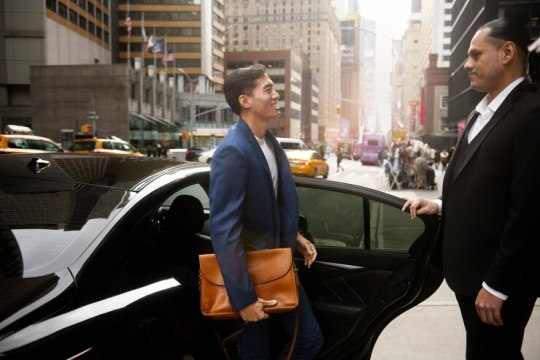
Why Choose Luxury Vehicle Management in London?
London, a global hub of business, culture, and tourism, demands impeccable transportation solutions. Luxury vehicle management is not just about providing high-end cars; it encompasses professional services, meticulous attention to detail, and seamless operations that reflect the city's premium lifestyle. Here are some reasons why luxury vehicle management is a game-changer:
Convenience: Enjoy hassle-free transportation tailored to your schedule.
Safety: Professionally maintained vehicles and expert chauffeurs ensure a secure ride.
Prestige: Arrive in style with luxury cars that make a lasting impression.
Customization: Services tailored to meet your unique requirements, whether for corporate events, personal trips, or celebrations.
Efficiency: Reliable and punctual services save time and eliminate travel-related stress.
We Universal: Redefining Luxury Vehicle Management in London
At We Universal, we pride ourselves on delivering unparalleled luxury vehicle management solutions in London. Our comprehensive services cater to diverse needs, ensuring that every client enjoys a premium experience. Here’s what sets us apart:
1. A Premium Fleet of Vehicles
Our extensive fleet includes some of the most luxurious and well-maintained vehicles in London. Whether you prefer a classic Rolls-Royce, a sleek Bentley, or a modern Mercedes-Benz, we have the perfect car for every occasion.
Business-Class Sedans: Ideal for corporate meetings and airport transfers.
Luxury SUVs: Spacious and perfect for group travel or family outings.
Prestige Cars: Make a statement with iconic brands like Aston Martin and Bentley.
2. Professional Chauffeurs
Our chauffeurs are not just drivers; they are highly trained professionals committed to delivering exceptional service.
Expertise: Deep knowledge of London’s routes and traffic patterns.
Etiquette: Polished, courteous, and customer-focused.
Discretion: Respecting client privacy and ensuring confidentiality.
3. Tailored Solutions
We understand that each client is unique. That’s why we offer personalized services to meet specific needs.
Corporate Travel: Impress clients and partners with seamless transportation.
Event Management: Perfect for weddings, galas, and social gatherings.
Personal Chauffeur Services: Enjoy the luxury of having a dedicated driver for the day.
4. Technology Integration
We leverage advanced technology to enhance your experience. From online booking systems to real-time tracking, our tech-driven approach ensures efficiency and convenience.
5. Eco-Friendly Options
Committed to sustainability, we offer a range of hybrid and electric luxury vehicles for environmentally conscious clients.
Benefits of Choosing We Universal for Luxury Vehicle Management
Choosing We Universal means choosing reliability, sophistication, and unparalleled customer service. Here are some key benefits:
1. Reliability
We guarantee punctuality and dependability, ensuring you reach your destination on time, every time.
2. Stress-Free Travel
Say goodbye to the hassles of driving, navigating traffic, or finding parking. With We Universal, you can sit back and relax.
3. Enhanced Image
Arriving in a luxury vehicle managed by professionals adds a touch of class to your personal or professional image.
4. Comprehensive Services
From one-off bookings to long-term vehicle management solutions, we cater to all requirements.
5. 24/7 Availability
Our services are available round the clock, ensuring that you have access to premium transportation whenever you need it.
Ideal Scenarios for Luxury Vehicle Management
Luxury vehicle management is not just about transportation; it’s about creating memorable experiences. Here are some situations where our services shine:
1. Corporate Events
Whether hosting an important business meeting or attending a conference, our luxury vehicles leave a lasting impression on clients and colleagues.
2. Airport Transfers
Start or end your journey with the comfort and convenience of a chauffeured luxury car. We cover all major London airports, including Heathrow, Gatwick, and London City Airport.
3. Weddings
Make your special day even more magical with a luxury car that complements your style. From bridal party transportation to guest transfers, we’ve got it covered.
4. Sightseeing Tours
Explore London’s iconic landmarks in the comfort of a luxury car. Our chauffeurs double as knowledgeable guides to enhance your experience.
5. Special Occasions
Celebrate milestones like anniversaries, birthdays, or graduations in style with our premium vehicles.
#When it comes to managing luxury vehicles in London#We Universal stands as a beacon of excellence. Our expertise in providing top-notch luxury vehicle management services ensures that clients#convenience#and sophistication at every turn. Whether for personal use#corporate needs#or special occasions#our services are designed to exceed expectations.#Why Choose Luxury Vehicle Management in London?#London#a global hub of business#culture#and tourism#demands impeccable transportation solutions. Luxury vehicle management is not just about providing high-end cars; it encompasses profession#meticulous attention to detail#and seamless operations that reflect the city's premium lifestyle. Here are some reasons why luxury vehicle management is a game-changer:#Convenience: Enjoy hassle-free transportation tailored to your schedule.#Safety: Professionally maintained vehicles and expert chauffeurs ensure a secure ride.#Prestige: Arrive in style with luxury cars that make a lasting impression.#Customization: Services tailored to meet your unique requirements#whether for corporate events#personal trips#or celebrations.#Efficiency: Reliable and punctual services save time and eliminate travel-related stress.#We Universal: Redefining Luxury Vehicle Management in London#At We Universal#we pride ourselves on delivering unparalleled luxury vehicle management solutions in London. Our comprehensive services cater to diverse ne#ensuring that every client enjoys a premium experience. Here’s what sets us apart:#1. A Premium Fleet of Vehicles#Our extensive fleet includes some of the most luxurious and well-maintained vehicles in London. Whether you prefer a classic Rolls-Royce#a sleek Bentley
0 notes
Text
Top 5 Auto Parts Manufacturers | Metalman Auto Ltd.
Metalman Auto Ltd. is proud to be ranked among the top 5 auto parts manufacturers in India, a testament to our dedication to quality and innovation. We specialize in producing a diverse range of metal components, including body panels, chassis parts, and assemblies for various automotive applications. Our cutting-edge facilities and experienced workforce enable us to deliver products that meet the stringent requirements of global automotive standards. We are continuously expanding our capabilities to include new technologies and materials, ensuring that we remain at the forefront of the industry. Our partnerships with leading OEMs and suppliers demonstrate our ability to deliver reliable, high-performance components that enhance vehicle safety and efficiency. With a focus on sustainability and technological advancement, Metalman Auto is setting new benchmarks in automotive component manufacturing.


#electric vehicles#metal fabrication#fabricationservices#oemparts#steel fabrication#supplier#oem manufacturing#manufacturer#stainless steel#vehicle transport#transportation#transport for london#ipo news#ipo alert#transport technology#transport service#stocks#business magazines#business standard#manufacturing#automotive parts#High-Volume Automotive Parts Manufacturing#markets#metalman auto#automotive industry#parts Manufacturin#automotive#car accessories#oem#custom metal parts manufacturer for oems
0 notes
Text
Experience Premium Travel with Luxury Van Hire and Motorbike Taxis in London: Prestige Cars and Couriers

When it comes to premium transport services in London, luxury van hire and motorbike taxis offer a unique and high-end travel experience. Whether you’re navigating the city’s bustling streets for business or leisure, Prestige Cars and Couriers delivers top-tier transportation that guarantees both comfort and style.
Luxury van hire provides the ultimate solution for those needing more space and comfort without compromising on elegance. Perfect for group travel, corporate events, or transporting delicate items, luxury vans are equipped with modern amenities to ensure a smooth and comfortable journey. Prestige Cars and Couriers offers a fleet of high-end vehicles, providing both professional drivers and an unforgettable experience. Whether you're heading to a meeting, the airport, or a special event, their luxury van hire service ensures you travel in style.
For those looking for a quicker, more thrilling way to navigate the city, motorbike taxis in London are the perfect option. Prestige Cars and Couriers also offers efficient and safe motorbike taxi services, allowing passengers to bypass traffic and get to their destination swiftly. These services are ideal for short-distance travel or when you're pressed for time but still want a comfortable ride.
What sets Prestige Cars and Couriers apart is their commitment to quality, luxury, and customer satisfaction. Whether you’re booking a luxury van hire for a business group or opting for a motorbike taxi in London for a fast, fun ride, their services are tailored to meet the highest standards.
For an unmatched travel experience in London, choose Prestige Cars and Couriers for your next journey. With a variety of transport options, including luxury van hire and motorbike taxis, you’ll enjoy seamless, stylish, and efficient travel every time
#- Luxury Van Hire#- Motorbike Taxi London#- Prestige Cars and Couriers#- Premium Transport London#- Executive Van Hire#- Motorbike Taxi Service#- London Chauffeur Service#- High-End Transport London#- Business Travel London#- Luxury Transportation London#- Fast Taxi London#- Group Travel London#- Stylish Transport London#- London Transport Services#- Comfortable Travel London
0 notes
Text
Gatwick Airport Chauffeur Service - Private Driver with Car Hire UK
Gatwick Airport Chauffeur Service Travel in Style and Comfort Start or end your journey with the elegance and convenience of our Gatwick Airport Chauffeur Service. Whether you’re travelling for business, leisure, or a special event, the Gatwick Airport Chauffeur Service by Crony Chauffeur Services guarantees a luxurious and hassle-free experience. Our premium service ensures a seamless and…

View On WordPress
#airport cab booking#airport cab service#airport cabs#airport cabs london#airport cars#airport london transfer#airport shuttle#airport taxi#airport taxi booking#airport taxi cab services#airport taxi london#airport taxi service#airport taxi transfers#airport transfers#airport transfers london uk#airporttaxis uk#booking airport transfers#bristol taxi airport#business chauffeur hire#cab to airport#call taxi cab#car hire with driver#car transport#car with driver on rent#chauffeur driven#chauffeur driver#chauffeur hire#chauffeur hire london#chauffeur service#chauffeur service cost
0 notes
Text

10 years of Clexa kisses (The Pursuit edition)
The Sanctum is decked out in surprisingly opulent style for an establishment this far out in the wilderness. The plush carpets and tasseled drapes, the crystal chandelier in the lobby, down to the snooty, crisply-uniformed staff manning the front desk could all be transported from a grand hotel in Paris or London. Or so Lexa imagines. The farthest east she’s been is Chicago, which is as near to a foreign country as she’s ever likely to get.
But that’s by the by. She isn’t here to admire the decor or the hospitality.
She has one singular concern in mind, and anticipation is coiled tight in her belly when she raps her knuckles against the door of the room at the end of the corridor.
Seconds trickle by.
While she waits, she leans a shoulder against the wall. Legs crossed at the ankles. Casual-like. Although inside her nerves are jangling like a gunslinger’s in the eerie lull before a quick draw.
She listens out for movement, hears some indistinct shuffling and scraping, then the faint patter of feet before the door is finally thrown open.
Without so much as a “howdy”, Clarke gets straight down to brass tacks. Pounces. Just grabs Lexa by the front of her blouse and yanks her inside the room, into a kiss so forceful it knocks the hat clean off Lexa’s head.
It’s more of a mauling than a kiss, but Lexa surely isn’t complaining. She’s always appreciated a girl with spirit and, heck, Clarke has it in spades. It’s only when they break for air that Lexa takes command. She spins them around and traps Clarke’s front against the closed door. Busies herself with the tiny fastenings on the dress while she sucks a possessive kiss at the top of Clarke’s spine, letting out a low growl when she can’t get the garment undone fast enough.
But Lexa triumphs eventually, shoving rough handfuls of silk from Clarke’s body, then she gets to work on loosening the stays of the corset. All the while Clarke is breathing heavily, half laughing at Lexa’s little grunts of frustration until at last she frees Clarke of the restrictive contraption, peeling it off and letting it land with a dull thud on the floor.
Lexa tugs Clarke back around by the elbow.
Only to pull in a soft gasp.
Because a perfect, narrow beam of sunlight is cast across Clarke’s features, catching her eyes and making them glow. Irises so astoundingly blue, they don’t seem real.
Lexa ain’t the religious sort, but Clarke in this light is verging on something holy.
She doesn’t know what her face is doing presently—whatever it is makes Clarke shake her head. “Don’t be looking at me like that.”
“Like what?”
“Like you intend to court me.”
Read on AO3
62 notes
·
View notes
Text
D-Day was 80 years ago today!
D-Day was the first day of Operation Overlord, the Allied attack on German-occupied Western Europe, which began on the beaches of Normandy, France, on 6 June 1944. Primarily US, British, and Canadian troops, with naval and air support, attacked five beaches, landing some 135,000 men in a day widely considered to have changed history.
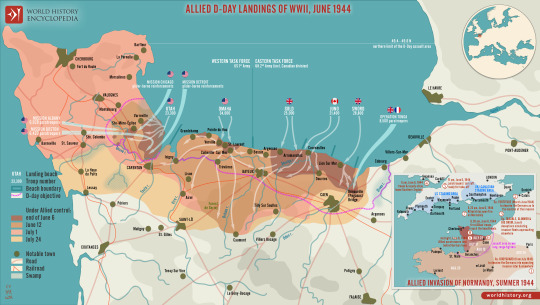
Where to Attack?
Operation Overlord, which sought to attack occupied Europe starting with an amphibious landing in northwest France, Belgium, or the Netherlands, had been in the planning since January 1943 when Allied leaders agreed to the build-up of British and US troops in Britain. The Allies were unsure where exactly to land, but the requirements were simple: as short a sea crossing as possible and within range of Allied fighter cover. A third requirement was to have a major port nearby, which could be captured and used to land further troops and equipment. The best fit seemed to be Normandy with its flat beaches and port of Cherbourg.
The Atlantic Wall
The leader of Nazi Germany, Adolf Hitler (1889-1945), called his western line of defences the Atlantic Wall. It had gaps but presented an impressive string of fortifications along the coast from Spain to the Netherlands. Construction of gun batteries, bunker networks, and observation posts began as early as 1942.
Many of the German divisions were not crack troops but inexperienced soldiers, who were spending more time building defences than in vital military training. There was a woeful lack of materials for Hitler's dream of the Atlantic Wall, really something of a Swiss cheese, with some strong areas, but many holes. The German army was not provided with sufficient mines, explosives, concrete, or labourers to better protect the coastline. At least one-third of gun positions still had no casement protection. Many installations were not bomb-proof. Another serious weakness was naval and air support. The navy had a mere 4 destroyers available and 39 E-boats while the Luftwaffe's (German Air Force's) contribution was equally paltry with only 319 planes operating in the skies when the invasion took place (rising to 1,000) in the second week.
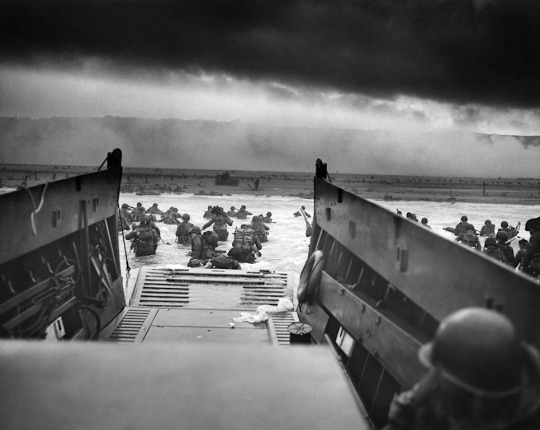
Neptune to Normandy
Preparation for Overlord occurred right through April and May of 1940 when the Royal Air Force (RAF) and United States Air Force (USAAF) relentlessly bombed communications and transportation systems in France as well as coastal defences, airfields, industrial targets, and military installations. In total, over 200,000 missions were conducted to weaken as much as possible the Nazi defences ready for the infantry troops about to be involved in the largest troop movement in history. The French Resistance also played their part in preparing the way by blowing up train lines and communication systems that would ensure the defenders could not effectively respond to the invasion.
The Allied fleet of 7,000 vessels of all kinds departed from English south-coast ports such as Falmouth, Plymouth, Poole, Portsmouth, Newhaven, and Harwich. In an operation code-named Neptune, the ships gathered off Portsmouth in a zone called 'Piccadilly Circus' after the busy London road junction, and then made their way to Normandy and the assault areas. At the same time, gliders and planes flew to the Cherbourg peninsula in the west and Ouistreham on the eastern edge of the planned landing. Paratroopers of the 82nd and 101st US Airborne Division attacked in the west to try and cut off Cherbourg. At the eastern extremity of the operation, paratroopers of the 6th British Airborne Division aimed to secure Pegasus Bridge over the Caen Canal. Other tasks of the paratrooper and glider units were to destroy bridges to impede the enemy, hold others necessary for the invasion to progress, destroy gun emplacements, secure the beach exits, and protect the invasion's flanks.
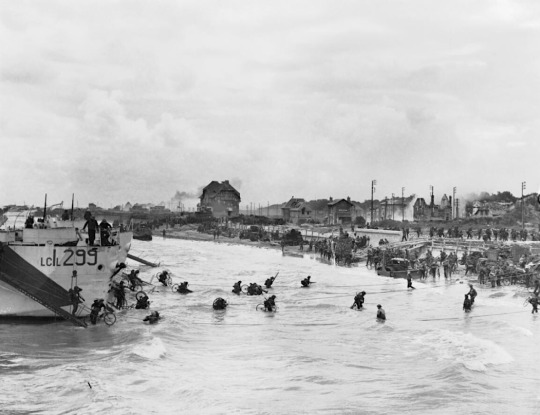
The Beaches
The amphibious attack was set for dawn on 5 June, daylight being a requirement for the necessary air and naval support. Bad weather led to a postponement of 24 hours. Shortly after midnight, the first waves of 23,000 British and American paratroopers landed in France. US paratroopers who dropped near Ste-Mère-Église ensured this was the first French town to be liberated. From 3.00 a.m., air and naval bombardment of the Normandy coast began, letting up just 15 minutes before the first infantry troops landed on the beaches at 6.30 a.m.
The beaches selected for the landings were divided into zones, each given a code name. US troops attacked two, the British army another two, and the Canadian force the fifth. These beaches and the troops assigned to them were (west to east):
Utah Beach - 4th US Infantry Division, 7th US Corps (1st US Army commanded by Lieutenant General Omar N. Bradley)
Omaha Beach - 1st US Infantry Division, 5th US Corps (1st US Army)
Gold Beach - 50th British Infantry Division, 30th British Corps (2nd British Army commanded by Lieutenant-General Miles C. Dempsey)
Juno Beach - 3rd Canadian Infantry Division (2nd British Army)
Sword Beach - 3rd British Infantry Division, 1st British Corps (2nd British Army)
In addition, the 2nd US Rangers were to attack the well-defended Pointe du Hoc between Utah and Omaha (although it turned out the guns had never been installed there), while Royal Marine Commando units attacked targets on Gold, Juno, and Sword.
The RAF and USAAF continued to protect the invasion fleet and ensure any enemy ground-based counterattack faced air attack. As the Allies could put in the air 12,000 aircraft at this stage, the Luftwaffe's aerial fightback was pitifully inadequate. On D-Day alone, the Allied air forces flew 15,000 sorties compared to the Luftwaffe's 100. Not one single Allied aircraft was lost to enemy fire on D-Day.
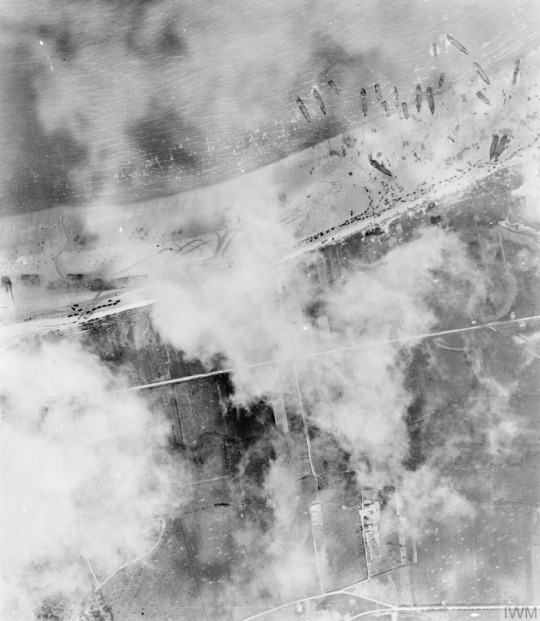
Packing Normandy
By the end of D-Day, 135,000 men had been landed and relatively few casualties were sustained – some 5,000 men. There were some serious cock-ups, notably the hopeless dispersal of the paratroopers (only 4% of the US 101st Air Division were dropped at the intended target zone), but, if anything, this caused even more confusion amongst the German commanders on the ground as it seemed the Allies were attacking everywhere. The defenders, overcoming the initial handicap that many area commanders were at a strategy conference in Rennes, did eventually organise themselves into a counterattack, deploying their reserves and pulling in troops from other parts of France. This is when French resistance and aerial bombing became crucial, seriously hampering the German army's effort to reinforce the coastal areas of Normandy. The German field commanders wanted to withdraw, regroup and attack in force, but, on 11 June, Hitler ordered there be no retreat.
All of the original invasion beaches were linked as the Allies pushed inland. To aid thousands more troops following up the initial attack, two artificial floating harbours were built. Code-named Mulberries, these were located off Omaha and Gold beaches and were built from 200 prefabricated units. A storm hit on 20 June, destroying the Mulberry Harbour off Omaha, but the one at Gold was still serviceable, allowing some 11,000 tons of material to be landed every 24 hours. The other problem for the Allies was how to supply thousands of vehicles with the fuel they needed. The short-term solution, code-named Tombola, was to have tanker ships pump fuel to storage tanks on shore, using buoyed pipelines. The longer-term solution was code-named Pluto (Pipeline Under the Ocean), a pipeline under the Channel to Cherbourg through which fuel could be pumped. Cherbourg was taken on 27 June and was used to ship in more troops and supplies, although the defenders had sunk ships to block the harbour and these took some six weeks to fully clear.
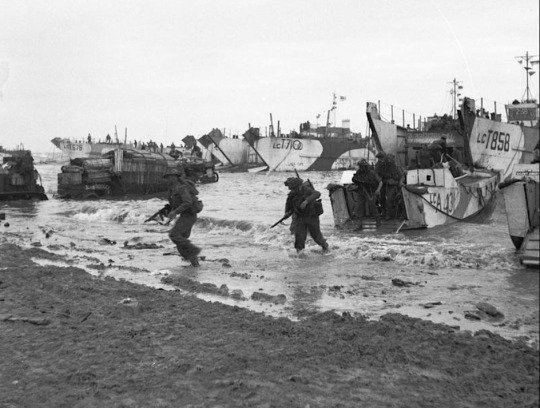
Operation Neptune officially ended on 30 June. Around 850,000 men, 148,800 vehicles, and 570,000 tons of stores and equipment had been landed since D-Day. The next phase of Overlord was to push the occupiers out of Normandy. The defenders were not only having logistical problems but also command issues as Hitler replaced Rundstedt with Field Marshal Günther von Kluge (1882-1944) and formally warned Rommel not to be defeatist.
Aftermath: The Normandy Campaign
By early July, the Allies, having not got further south than around 20 miles (32 km) from the coast, were behind schedule. Poor weather was limiting the role of aircraft in the advance. The German forces were using the countryside well to slow the Allied advance – countless small fields enclosed with trees and hedgerows which limited visibility and made tanks vulnerable to ambush. Caen was staunchly defended and required Allied bombers to obliterate the city on 7 July. The German troops withdrew but still held one-half of the city. The Allies lost around 500 tanks trying to take Caen, vital to any push further south. The advance to Avranches was equally tortuous, and 40,000 men were lost in two weeks of heavy fighting. By the end of July, the Allies had taken Caen, Avranches, and the vital bridge at Pontaubault. From 1 August, Patton and the US Third Army were punching south at the western side of the offensive, and the Brittany ports of St. Malo, Brest, and Lorient were taken.
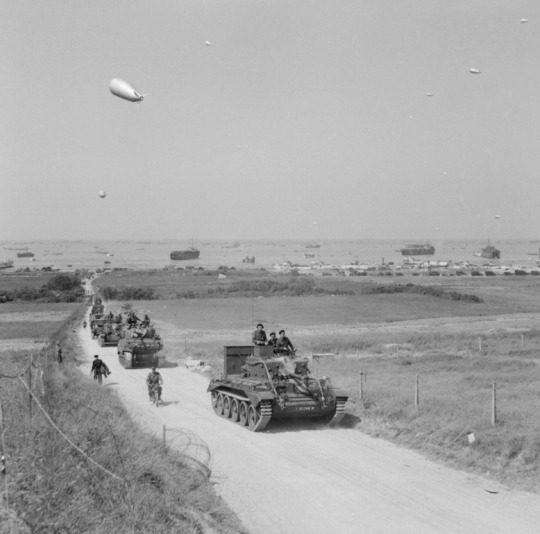
German forces counterattacked to try and retake Avranches, but Allied air power was decisive. Through August 1940, the Allies swept southwards to the Loire River from St. Nazaire to Orléans. On 15 August, a major landing took place on the southwest coast of France (French Riviera landings) and Marseille was captured on 28 August. In northern France, the Allies captured enough territory, ports, and airfields for a massive increase in material support. On 25 August, Paris was liberated. By mid-September, the Allied troops in the north and south of France had linked up and the campaign front expanded eastwards pushing on to the borders of Germany. There would be setbacks like Operation Market Garden of September and a brief fightback at the Battle of the Bulge in December 1944, but the direction of the war and ultimate Allied victory was now a question of not if but when.
138 notes
·
View notes